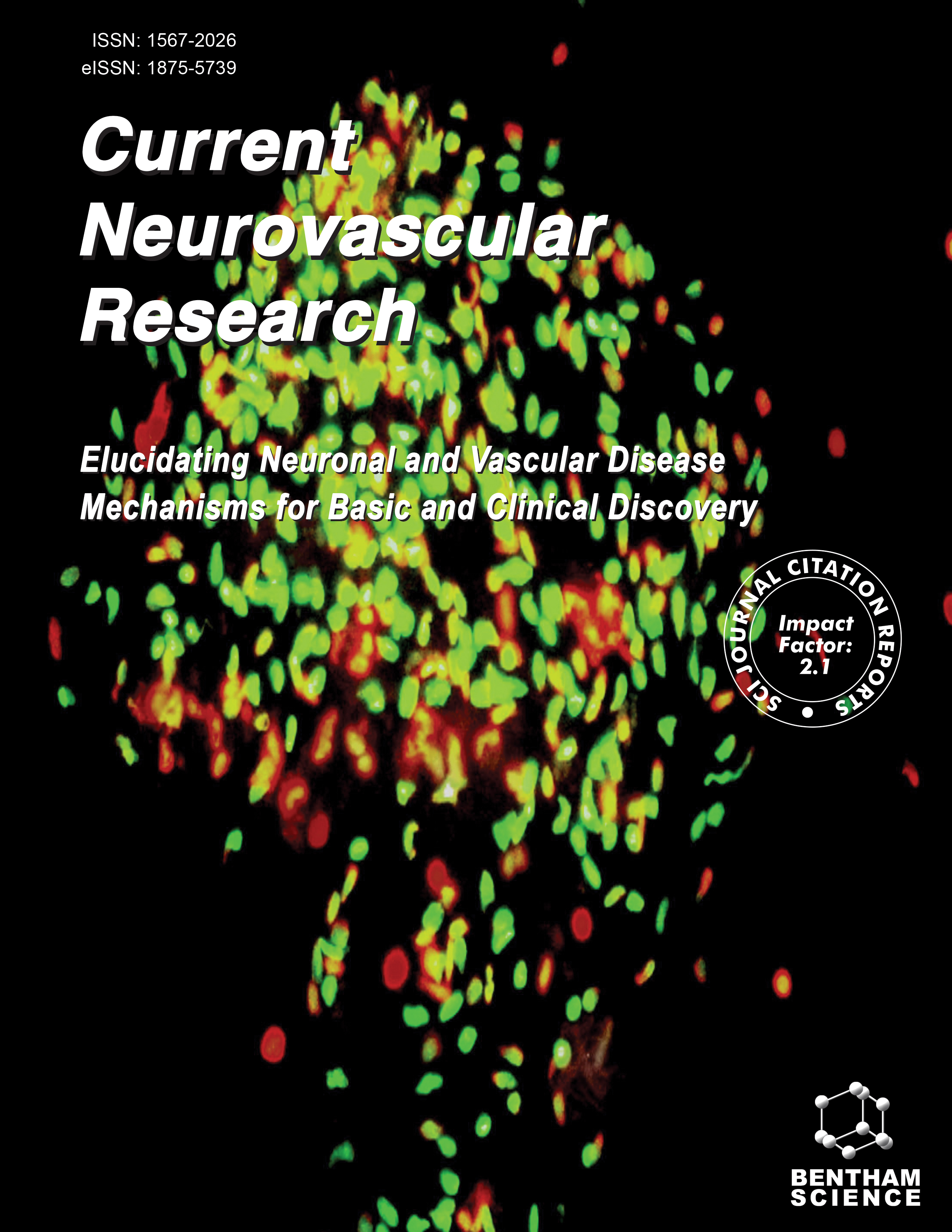- Home
- A-Z Publications
- Current Neurovascular Research
- Previous Issues
- Volume 2, Issue 4, 2005
Current Neurovascular Research - Volume 2, Issue 4, 2005
Volume 2, Issue 4, 2005
-
-
The Sirtuin Inhibitor Nicotinamide Enhances Neuronal Cell Survival During Acute Anoxic Injury Through AKT, BAD, PARP, and Mitochondrial Associated "Anti-Apoptotic" Pathways
More LessAuthors: Z. Z. Chong, S.- H. Lin, F. Li and K. MaieseUnderstanding the role of nicotinamide (NIC) in different cell systems represents a significant challenge in several respects. Recently, NIC has been reported to have diverse roles during cell biology. In the absence of NIC, sirtuin protein activity is enhanced and pyrazinamidase/nicotinamidase 1 (PNC1) expression, an enzyme that deaminates NIC to convert NIC into nicotinic acid, is increased to lead to lifespan extension during ca Read More
-
-
-
Estrogen Activates Classical and Alternative Mechanisms to Orchestrate Neuroprotection
More LessAuthors: R. Marin, B. Guerra, R. Alonso, C. M. Ramirez and M. DiazEvidence for a protective role of estradiol in neurodegenerative diseases has steadily increased over the past decade, though the mechanisms of action and the participation of true estrogen receptors (ERs) have proven a complex score. The protective effects of estrogens take place partly through pathways involving canonical ER activation, which is constitutively expressed in many brain regions and is able to initiate gene tr Read More
-
-
-
Sympathetic Nervous System, Genes and Human Essential Hypertension
More LessAuthors: H. Zhu, J. Poole, Y. Lu, G. Harshfield, F. Treiber, H. Snieder and Y. DongThe sympathetic nervous system (SNS) is the first line of defense in the response to environmental stress through its regulation of second-to-second changes in blood pressure (BP). Both the activity of the SNS and the therapeutic responses to SNS agonists and antagonists are known to be highly variable in the population. "Small" changes caused by single nucleotide polymorphisms (SNPs) of SNS genes may have considerab Read More
-
-
-
Stromal Derived Growth Factor-1alpha as a Beacon for Stem Cell Homing in Development and Injury
More LessAuthors: C. M. Claps, K. E. Corcoran, K. J. Cho and P. RameshwarThis review extrapolates the functions of SDF-1α and its receptor, CXCR4, as regulators of hematopoietic stem cells and discusses their potential roles in the development and regeneration of tissues. The discussion focuses on the repair of neural tissues while parallels are made with bone marrow hematopoietic stem cells. Overall, the organization links the basic biology of SDF-1α and CXCR4 to topics in medicine and show Read More
-
-
-
Vital Elements of the Wnt-Frizzled Signaling Pathway in the Nervous System
More LessAuthors: F. Li, Z. Z. Chong and K. MaieseWnt proteins are cysteine-rich glycosylated proteins named after the Drosophilia Wingless (Wg) and the mouse Int-1 genes that play a role in embryonic cell patterning, proliferation, differentiation, orientation, adhesion, survival, and programmed cell death (PCD). Wnt proteins involve at least two intracellular signaling pathways. One pathway controls target gene transcription through β-catenin, generally referred to as th Read More
-
-
-
Cerebrovascular Damage as a Cause for Alzheimer's Disease
More LessAuthors: C. Humpel and J. MarksteinerAlzheimer's disease is a progressive brain disorder that gradually destroys a patient's memory function and ability to carry out daily activities. According to the prevailing amyloid cascade hypothesis, Alzheimer's disease is initiated by amyloid ß-peptide accumulation leading to neuronal toxicity. The neurofibrillary tangle deriving from hyperphosphorylated tau and synapse loss are also key features for Alzheimer's disease Read More
-
-
-
Experimental Models of Relapsing-Remitting Multiple Sclerosis: Current Concepts and Perspective
More LessMultiple sclerosis (MS) and its model experimental autoimmune encephalomyelitis (EAE) are debilitating paralytic diseases caused by inflammation, demyelination and axonal degeneration of the central nervous system (CNS). Whilst the autoimmune nature of MS is strongly suggested by evidence of myelin specific autoreactive T cells and antibodies, EAE is an experimentally induced CNS specific autoimmune disease. As o Read More
-
Volumes & issues
-
Volume 21 (2024)
-
Volume 20 (2023)
-
Volume 19 (2022)
-
Volume 18 (2021)
-
Volume 17 (2020)
-
Volume 16 (2019)
-
Volume 15 (2018)
-
Volume 14 (2017)
-
Volume 13 (2016)
-
Volume 12 (2015)
-
Volume 11 (2014)
-
Volume 10 (2013)
-
Volume 9 (2012)
-
Volume 8 (2011)
-
Volume 7 (2010)
-
Volume 6 (2009)
-
Volume 5 (2008)
-
Volume 4 (2007)
-
Volume 3 (2006)
-
Volume 2 (2005)
-
Volume 1 (2004)
Most Read This Month
Article
content/journals/cnr
Journal
10
5
false
en


